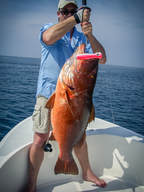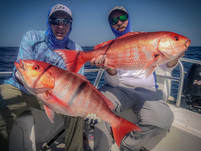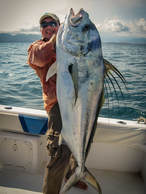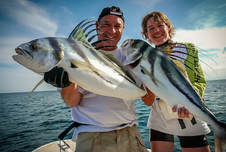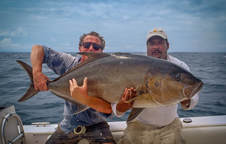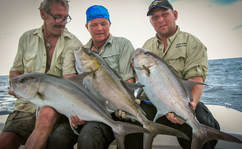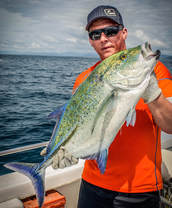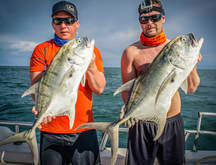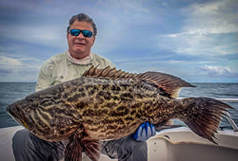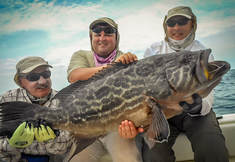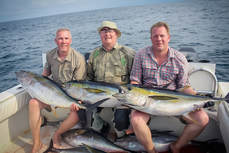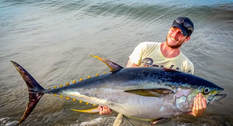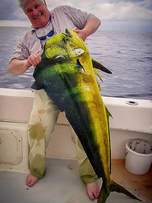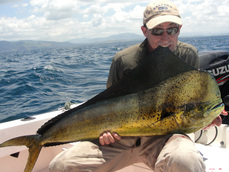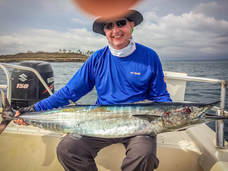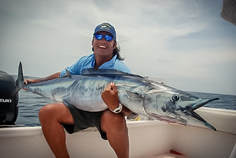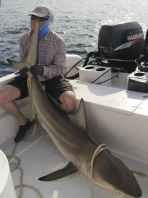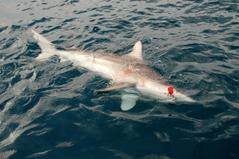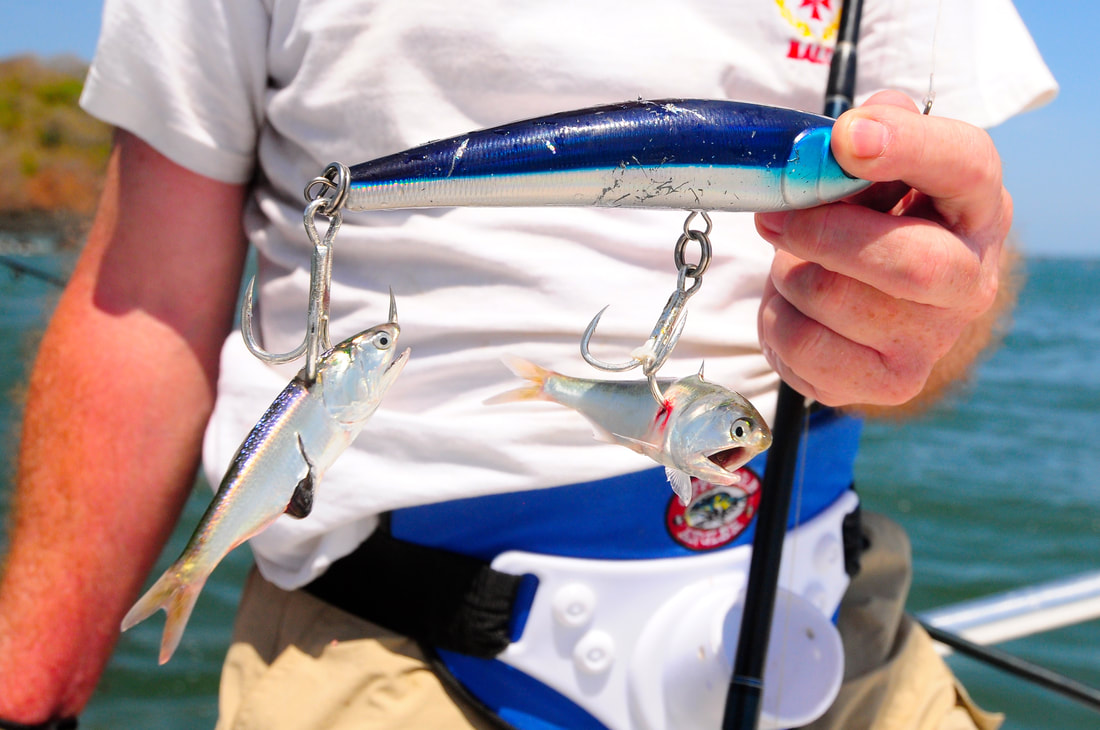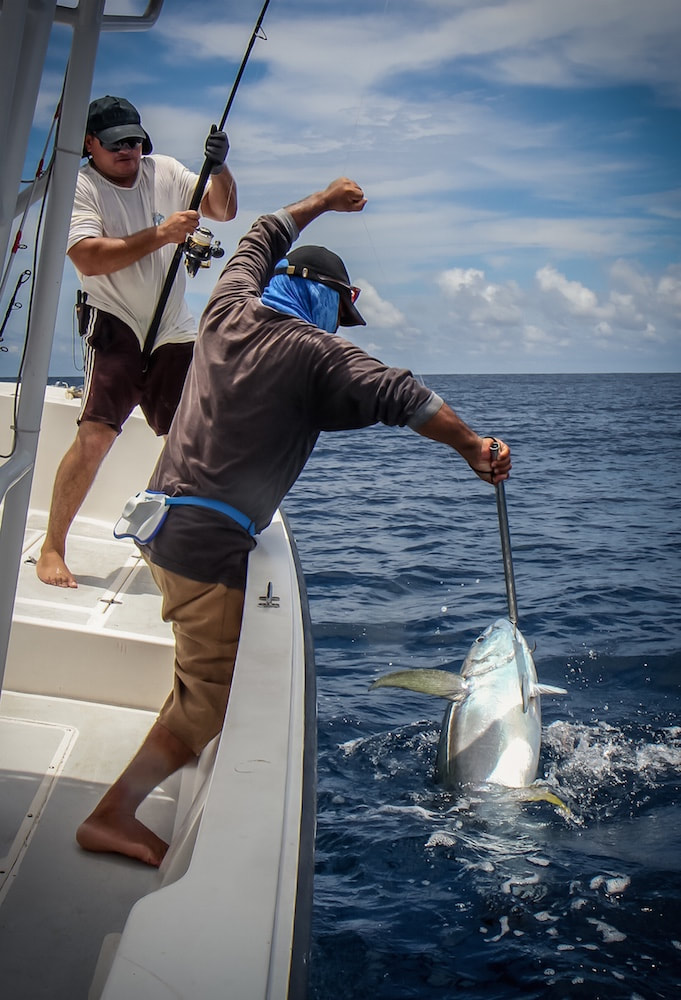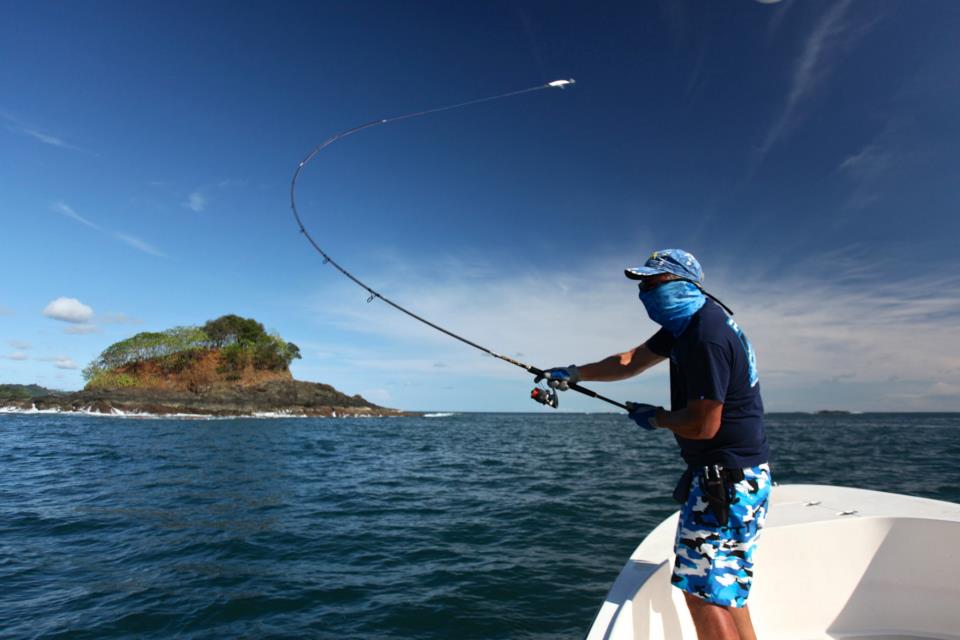|
Most interesting fish species:
While roosterfish, cubera snapper, yellowfin tuna and amberjack are the emblematic species of Panama and the most sought-after species for popping and jigging addicts, the waters of the Tuna Coast are blessed with an amazing variety with no less than 35 interesting species being caught regularly on artificials. Days with 12 or more different species caught and released are quite usual.
|
Les poissons qui nous intéressent:
Sans nul doute, les poissons coqs, carpes rouges, thons jaunes et sérioles sont les espèces emblématiques du Panama et les plus recherchées au popper et au jig. Mais les eaux de Pedasi recèlent de nombreux autres trésors avec pas moins de 35 espèces intéressantes capturées régulièrement aux leurres. Les journées ou l'on relache 12 espèces différentes ou plus sont la norme.
|
And also: sailfish, sierra mackerel, pacific bonito, marlin, rainbow runner, corvina, barracuda, tarpon, milkfish, needlefish, permit, snook, etc.
Inshore Variety !
The variety of species one can catch on artificials down here is a real blessing and it is what makes fishing the Tuna Coast of Panama so special and interesting. Wether fishing topwater or down deep, you never know what's going to hit your lure. Here is a gallery to illustrate this incredibly varied fishery. There is some trophy fish in there but we also wanted to show the less famed species which constitute most of the catches and that offer great fights and fun on the appropriate spinning gear. ACTION and VARIETY ! This is what lure fishing on the Tuna Coast delivers. And the best part is that all that action starts only a short boat ride away, if not in the mooring field !
Which time of the year should I visit ?
We often get asked what is the best month for a fishing trip in Panama with Panafishing Adventures. There is no short answer to that question and everyone will have a different opinion on that matter depending on their preferences, priority and targets. Below is the rule of thumb that will help you determine which season is best for you. We strongly encourage returning customers to try another time of the year, for something a little different and to eventually experience the full spectrum of variety the Tuna Coast can offer.
Overall, the fishing is good year-round and the coastal species that we primarily target are here anytime, as you can see in our reports section. There is no low season and the quality of the fishing and the results vary more from day to day or week to week than from one month or one season to another. However, the conditions, the availability and the behaviour of some species changes throughout the year, so you may get a totally different experience depending on when you decide to come. Please remember the following is a general guideline only. Fishing remains highly unpredictable and throughout the year pretty much anything can happen.
Overall, the fishing is good year-round and the coastal species that we primarily target are here anytime, as you can see in our reports section. There is no low season and the quality of the fishing and the results vary more from day to day or week to week than from one month or one season to another. However, the conditions, the availability and the behaviour of some species changes throughout the year, so you may get a totally different experience depending on when you decide to come. Please remember the following is a general guideline only. Fishing remains highly unpredictable and throughout the year pretty much anything can happen.
Dry Season (December to May) :
Most years, the dry season will settle during the month of December, and from early January to late April there is virtually no rain. With the dry weather comes a regular wind from the north, averaging 15 knots but that can go up to 25 knots for days in a row, especially during the months of January and February. Calm days occur, especially in late March and April, but are definitely not the norm.
That wind, fortunately, is as much a blessing as it is a curse. It will create an upwelling that will considerably cool down the water at the coast, which will trigger the sardine run that brings billions of sardines at the coast and the big fish in their wake.
Most years, the dry season will settle during the month of December, and from early January to late April there is virtually no rain. With the dry weather comes a regular wind from the north, averaging 15 knots but that can go up to 25 knots for days in a row, especially during the months of January and February. Calm days occur, especially in late March and April, but are definitely not the norm.
That wind, fortunately, is as much a blessing as it is a curse. It will create an upwelling that will considerably cool down the water at the coast, which will trigger the sardine run that brings billions of sardines at the coast and the big fish in their wake.
|
At that time of the year, most of the fishing is done really close to shore because this is where the fish are. We mostly fish the south coast where the wind blows offshore, offering some rather protected water nearshore.
This is the season when the topwater action is the most reliable, as many species will feed and frenzy on the countless sardine balls and won't think too much before hitting a topwater lure. The jigging is also excellent but when the wind blows really hard it does not help with the drifts. To summarize, the dry season is a good time to visit for anglers who give priority to numbers and topwater action, and who don't mind windy conditions. |
Green Season (May to December) :
We like to call it green season, as opposed to rainy season, because it is really not that bad weather-wise. We are in the driest part of Panama where the rainfall is about half that of the Chiriqui, the Darien or the Atlantic side of Panama. June and November will usually have nice weather and very calm conditions. The most rainy months are August, September and October, but even then it only rains about 1 day out of 2 in average, usually for a few hours at max, and it's common to have 2 or 3 days of perfect sun in a row.
We like to call it green season, as opposed to rainy season, because it is really not that bad weather-wise. We are in the driest part of Panama where the rainfall is about half that of the Chiriqui, the Darien or the Atlantic side of Panama. June and November will usually have nice weather and very calm conditions. The most rainy months are August, September and October, but even then it only rains about 1 day out of 2 in average, usually for a few hours at max, and it's common to have 2 or 3 days of perfect sun in a row.
|
During the transition months of June and November, the seas are mostly flat. Throughout the peak of the green season, many days are calm and overcast, making for enjoyable, not-too-warm conditions to go fishing.
Fishing-wise, it is the best time for variety, as all Panama species are around and because the calm conditions allow us to fish all spots and further offshore. The notable difference is the availability of pelagic species that come closer to shore during those months. Of particular importance are the yellowfin tunas of all sizes, that usually start to appear in May, and will gradually increase in size and numbers until we reach the peak tuna season in July, August and September. Green Season is also the best time of the year for a chance at a trophy roosterfish, cubera snapper or both. Conditions are better for the big fish spots, and what is lost in terms of numbers compared to the dry season is compensated by the bigger average size. People who clearly favor numbers and action over average size, or, on the opposite, who want to focus on trying for a trophy fish, may want to take that into consideration when chosing when to come. To summarize, the green season fishing is more varied and may be a safer bet if your main target is a trophy-sized roosterfish or cubera snapper. Those who absolutely want to combine the regular « inshore » fishing with some big yellowfin tuna chasing should visit between mid-June and mid-October. |
Please, once again, don't believe that dry season is only about small fish and green season is slow. The above are guidelines only and meant to help you decide when to visit. Fishing is fishing: we have big fish, action-packed and slower weeks throughout the year, and anybody who likes fishing will thoroughly enjoy any time of the year providing the fishing is regular at least. Browsing through our reports and news section may be the best way to realise the above and not overthink about chosing the best time. The best time is anytime.
|
Jan, Feb, March & April
+ topwater activity inshore + sunny everyday + best for numbers and action - often windy |
May & June
+ calm seas + best chances at a trophy fish + best for variety - big tunas still far out in May |
July, Aug. & Sept.
+ big tunas + best chances at a trophy fish + best for variety - rain factor |
Oct, Nov & early Dec
+ calm seas around November + best chances at a trophy fish + best for variety - rainy in October |
Saisons de pêche
|
Les espèces côtières sont présentes toute l'année. La saison des pluies (de mai à fin novembre) n'affecte pas la pêche, nous sommes dans la région la plus sèche du Panama. La saison verte est la meilleure en terme de variété d'espèces et de techniques, car les pélagiques sont présents et les conditions calmes nous permettent de pêcher tous les spots. Si les gros thons jaunes sont un de vos objectifs premier, alors juillet, aout et septembre sont les mois a privilégier. Pendant la saison sèche (décembre à fin avril), on pêchera surtout à la côte. Des millions de sardines envahissent nos spots avec de nombreuses chasses. C'est la meilleure saison pour le popper et la pêche de surface en général. Sachez toutefois que les conditions sont souvent venteuses. |
|
janvier, fevrier, mars & avril
+ activité de surface a la côte + grand beau temps + le top en terme de nombre de prises - venteux |
Mai et Juin / Oct, Nov et début Dec.
+ mer calme + probabilités de poisson trophée + le top en terme de varieté - selon les années, pas de gros thons |
Juillet, Aout et Septembre
+ saison des gros thons jaunes + probabilités de poisson trophée + le top en terme de varieté - pluies |
|
Dry season fishing:
|
Green season fishing:
|

